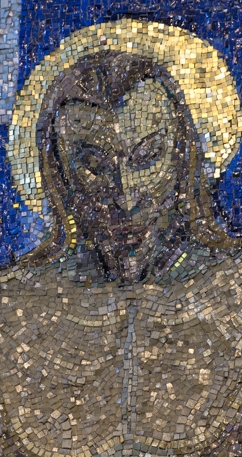Historic religious mosaic in danger
Reporter: Rosalyn Roden
Date published: 30 January 2017
A PLEA to save a "unique and historic" piece of 20th century artwork was voiced after its home came under threat.
The piece in question is an eight-metre-high mosaic of Christ on the cross which was built in situ at Holy Rosary Church in Fitton Hill.
Parishioners and experts alike are concerned about the future of the art after Salford Diocese announced the church is earmarked for closure.
Professionals who have examined the work, produced by Hungarian artist Georg Mayer-Marton, emphasised its historic and cultural importance.
Others have urged the Bishop of Salford, the Rt Rev John Arnold, to reconsider his decision to close the church building.
The great nephew of immigrant artist Mayer-Marton, Nick Braithwaite, said: "This is an historically important and unique artwork. It would be a crying shame and an act of iconoclasm if such a beautiful religious work were to be demolished. We are hoping the diocese will think again."
Natural stone and luminous glass tesserae - small tiles - make up the intricate detail of the crucifixion scene.
Examinations revealed that the back-drop to the original work, dated 1955, was painted over with white emulsion in 1980.
However area paint tests showed that the covered background could be restored to its original form.
The hidden artwork behind the dramatic crucifixion scene shows St John to Jesus' left and Christ's mother Mary on his right.
Professor of the history of western art at University of Glasgow Clare Willsdon said of the piece: "Mayer-Marton's imaginative approach in itself makes his Oldham mural worthy of careful preservation?an essential part not only of the mid-20th-century legacy of 'emigré' culture but also of the larger histories of mural decoration in Britain and of the revival of mosaic technique."
Former keeper of art galleries at National Museums Liverpool Julian Treuherz said of the author: "It is his mosaics that are his most distinguished and powerful works."
Others described Mayer-Marton's surviving mosaic as "a work of serious aesthetic and religious significance on par with some of the strongest works of modern ecclesial art in Britain".
For the past six months former parishioner of Holy Rosary Steve Haines has thrown all his efforts into securing the long-term future of the work.
Mr Haines, of Carrington, made contact with Mr Braithwaite via the Mayer-Marton website.
He said: "We are hoping for some kind of effort for conservation, preservation and restoration."
Most Viewed News Stories
- 1Police issue appeal following fatal collision on Asda car park in Shaw
- 2Two arrested following early morning raids in Royton
- 3FCHO condemns vandals who broke into Holts Community Centre and set fire to an outbuilding
- 4Plans proposed to turn former Clough Manor hotel into 'multi-service hub'
- 5Oldham poets transform dementia experience into book of warmth and hope





